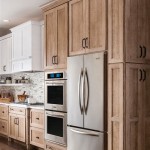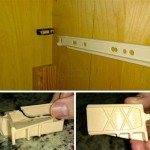How to Stain Wood Kitchen Cabinets: A Complete Guide
Whether you're looking to refresh your kitchen's appearance or give your old cabinets a new lease on life, staining them is a relatively easy and affordable DIY project. With a little preparation and know-how, you can achieve stunning results that will transform the look and feel of your kitchen.
1. Preparation
Before you start staining, it's crucial to prepare your cabinets and work area. Remove all hardware, including knobs, pulls, and hinges. Clean the cabinets thoroughly with a degreaser or denatured alcohol to remove any dirt, grease, or debris. If your cabinets have a glossy finish, you'll need to sand them lightly to create a rougher surface for the stain to adhere to.
2. Choosing the Right Stain
The choice of stain will depend on the desired color and finish. Oil-based stains penetrate deep into the wood, providing a durable and rich finish, while water-based stains are easier to apply and dry faster. Consider the natural color of your wood and experiment with small samples of stain on a scrap piece of wood before committing to a specific color for your entire kitchen.
3. Applying the Stain
Once you have chosen your stain, apply it evenly to the cabinets using a brush, foam brush, or rag. Work in sections, applying along the grain of the wood to prevent streaks. Allow the stain to penetrate for the recommended time according to the manufacturer's instructions.
4. Wiping Off Excess Stain
After letting the stain penetrate, wipe off any excess with a clean cloth to prevent the finish from becoming too dark. Use a dry cloth for oil-based stains and a damp cloth for water-based stains. Be thorough, but avoid over-wiping, as this can remove too much stain and create blotches.
5. Topcoat
To protect the stain and enhance the durability of your cabinets, apply a topcoat. Options include polyurethane, lacquer, or shellac. Polyurethane is a hard, durable finish that provides excellent protection, while lacquer is a thinner, faster-drying option that leaves a glossy finish. Shellac is a natural finish that imparts a warm, amber hue and enhances the wood's grain.
6. Hardware Reinstallation
Once the topcoat has dried completely, you can reinstall the hardware. Be sure to drill pilot holes for screws to prevent splitting the wood. If desired, you can lightly distress the cabinets or add decorative details to personalize the look.
Tips for a Professional Finish

Staining Kitchen Cabinets Pictures Ideas Tips From

How To Stain Wood Cabinets True Value

How To Stain Oak Cabinetry Tutorial The Kim Six Fix

How To Make Rustic Kitchen Cabinets By Refinishing Them The Best Stain Color Amanda Katherine

Staining Your Wood Cabinets Darker Young House Love

15 Stained Wood Kitchen Cabinets To Warm The Heart Of Your Home

The New Cabinet Stain Colour For Kitchens Trends Wood

How To Stain Dark Or Yellow Kitchen Cabinets Lighter

Diy Staining Oak Cabinets Eclectic Spark

Painted Vs Stained Cabinets Jm Kitchen And Bath Design
Related Posts








